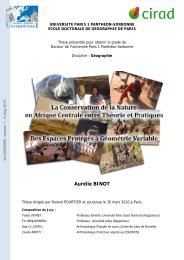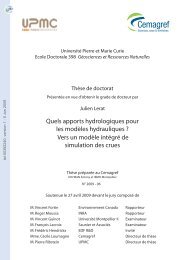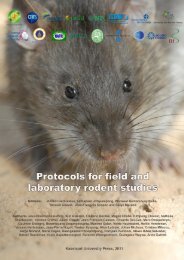Impact des métaux lourds sur les interactions plante/ver de terre ...
Impact des métaux lourds sur les interactions plante/ver de terre ...
Impact des métaux lourds sur les interactions plante/ver de terre ...
You also want an ePaper? Increase the reach of your titles
YUMPU automatically turns print PDFs into web optimized ePapers that Google loves.
Partie C : Résultats – Chapitre C-Iand 1000 mg.kg -1 lead respectively. The lead concentration in the shoots was significantlylower than in the roots, regard<strong>les</strong>s of the concentration of lead. Howe<strong>ver</strong>, the ratio of leadtranslocated to the aerial parts (TF = concentration in the shoots / concentration in the roots)was 0.053 (500 mg.kg -1 ) and 0.152 (1000 mg.kg -1 ) which is significantly <strong>de</strong>pen<strong>de</strong>nt on theconcentration of lead in the soil.Inoculating the soil with earthworms resulted in a positive increase in the quantity ofaccumulated lead in the roots and in the shoots (Table 2). This increase was significant forboth concentrations of lead. In the presence of earthworms, the total lead uptake in the shootsand roots was 3-fold and 2-fold higher at lead concentrations of 500 mg.kg -1 and 1000 mg kg -1respectively.The TF was also significantly higher in the presence of earthworms for the soil with1000 mg.kg -1 lead.tel-00486649, <strong>ver</strong>sion 1 - 26 May 20104. DiscussionThe <strong>sur</strong>vival rate observed for the plants growing in lead contaminated soil after onemonth, the absence of visible damage to the leaves and the significant increase in growthconfirmed the high metal tolerance of Lantana camara (Verbenaceae). In lead contaminatedsoil, Lantana camara achieved a higher biomass than the controls. These results can becompared to those of Epel<strong>de</strong> et al. (24) for the hyperaccumulator plant Thlaspi caeru<strong>les</strong>censwhich, when exposed to Cd and Zn showed higher biomass and values of photosyntheticpigments than those observed in controls.At first, Lantana camara accumulated lead in its roots and then the lead was transferredtowards the aerial parts where it was also accumulated in large quantities. For bothconcentrations of lead in the soil, the shoot-to-root lead concentration ratio was <strong>les</strong>s than 1.This is a lower value than expected for hyperaccumulator plants which typically have a shootto-rootmetal concentration ratio of more than 1 (25). Howe<strong>ver</strong>, the potential of Lantanacamara (Verbenaceae) for lead extraction was only disco<strong>ver</strong>ed <strong>ver</strong>y recently by Diep (19) andso there are few studies of its metal tolerance and phytoextraction potential. Further studies onL. camara physiology, currently un<strong>de</strong>rway, may explain this difference in the shoot-to rootlead ratio.61
















